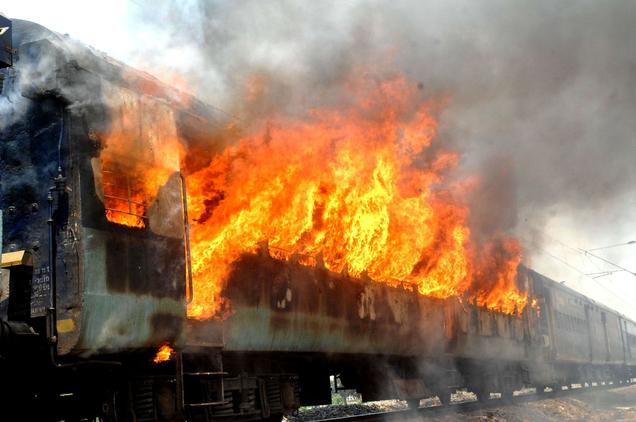What is the peak fire heat release rate during a train fire? This is the most common question in tunnel ventilation design. NPFA 130, 2017 editions, has added a new Annex H to provide background and approaches to the development of fire profiles (fire heat release rates expressed as a function of time) .
“Several references provided a reasonably good overview of a number of methodologies for predicting design fire profiles (fire heat release rate time curve) [2][3][4]. More recent methodologies include, but not limited to, the following:
- CFD Modeling of Fire Profiles with Cone Calorimeter Tests of Train Materials
This methodology includes cone-calorimeter tests of train materials, and computer modeling of fire growth and decay for a fire originated in a train’s interior in the presence of accelerants. Several CFD programs have been used in predicting fire profiles for transit and rail projects in the United States since 2005. The CFD programs are validated for their intended use, and predict pre- and post-flashover fire profiles. When selecting a computer program, it is important to select the program that best fits the need of the problem rather than to select the program based on availability. The following conditions should be considered when building a CFD model for predicting fire profiles: 1) quantity and properties of accelerants; 2) fire characteristic of car interior materials measured according to ASTM E1354; 3) the layout of the car interiors including seating layouts, orientations and dimensions; 4) bags and luggage carried by passengers; 5) overall thermal transmission value for vehicle body; 6) openings, including windows and doors; 7) oxygen levels; and 8) mechanical and natural ventilation.
- Full-Scale Fire Tests
A handful of full-scale train fire tests have yielded data to estimate the fire profiles. The 1995 EUREKA project [5] showed that an intercity train reached a peak fire heat release rate of 12 MW in 25 minutes, while a Metro train car reached a peak fire heat release rate of 35 MW in 5 minutes. A Baku Metro train fire (Azerbaijan, 1995) was estimated to reach 100 MW in about 30-45 minutes, and in 2002 a Frankfurt Metro fire model reached 5.6 MW in 30 minutes [3]. The fire profile studies focused on accidental fires such as debris or transient car loadings becoming ignited, or mechanical failure causing the train car itself to ignite.
More recent full-scale fire tests have focused on fires where a deliberate attempt was made to ignite and flashover the train car. The full-scale fire tests in Sweden [6] used a commuter train and found that the maximum fire heat release rate of 76.7 MW was achieved in 12.7 minutes in one of the tests, and the corresponding value for another test with the train walls and ceiling covered by aluminum was 77.4 MW occurred at 117.9 minutes after ignition. The general shape of the two fire curves are almost the same. Other full-scale fire tests in Canada used a subway car which reached a maximum FHRR of 52.5 MW in 2.3 minutes, and a railway car which reached a peak FHRR of 32 MW in 18 minutes [7]. A fourth test was performed in Australia, where a passenger rail car reached a maximum FHRR of 13 MW in 2.3 minutes [8].
- Impacts on Ventilation System Design
The train fire profile has a major impact on the station and tunnel ventilation design. The design fire scenarios and fire profiles should be determined based on the perceived threats. In response to increased awareness that transit and passenger rail systems are potential terrorist targets, some systems are designed for significant incendiary fires. Recent station fire analyses, in most cases, a “medium” fire growth rate of a t-squared fire discussed in NFPA 92 has been used. The decision was based on cost, the inferred risk or a formal threat and vulnerability assessment.”
References. The following references are cited in this post.
- Hadjisophcleous, G., Lee, D.H. and Park, W.H., Full-scale Experiments for Heat Release Rate Measurements of Railcar Fires, presented at the Fifth International Symposium on Tunnel Safety and Security, New York, USA, 14-16 March, 2012.
- Sørlie, R. and Mathisen, H.M., EUREKA-EU 499 Firetun-Project: Fire Protection in Traffic Tunnels, SINTEF, Applied Thermodynamics, 1994.
- Chiam, Boon Hui, Numerical Simulation of a Metro Train Fire, Fire Engineering Research Report 05/1, Department of Civil Engineering, University of Canterbury, Christchurch, New Zealand, June 2005.
- Li, S., Louie, A., and Fuster, E, The Impacts of Train Fire Profiles on Station Ventilation System Design, presented at the 15th International Symposium on Aerodynamics, Ventilation & Fire in Tunnels, Barcelona, Spain, 18-20 September 2013.
- Parsons Brinckerhoff Quade & Douglas, Inc., “Subway Environmental Design Handbook (SEDH), Volume II, Subway Environment Simulation Computer Program, SES Version 4.1, Part I User’s Manual”, Second Edition, February 2002, US Department of Transportation, Washington, DC, USA.
- Kennedy, W.D., Ray, R.E. and Guinan, J.W., A Short History of Train Fire Heat Release Calculations, presented at the 1998 ASHRAE Annual Meeting, Toronto, Ontario, Canada, June 1998.
- Lonnemark, A, et al., Large-scale Commuter Train Fire Tests – Results from the METRO Project, presented at the Fifth International Symposium on Tunnel Safety and Security, New York, USA, 14-16 March, 2012.
- White, N., Dowling, V. and Barnett, J., Full-scale Fire Experiment on a Typical Passenger Train, In Fire Safety Science, Proceedings of the Eight International Symposium, Beijing, International Association for Fire Safety Science, Boston, MA, 2005.
(Featured image from www.newspapad.com)

